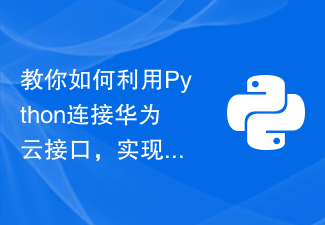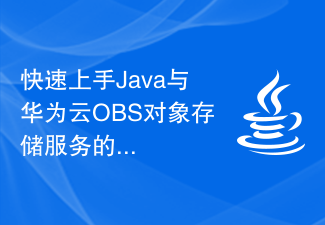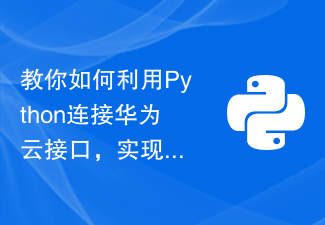 Backend Development
Backend Development Golang
Golang Help you become an expert in connecting Go language and Huawei Cloud interface
Help you become an expert in connecting Go language and Huawei Cloud interfaceHelp you become an expert in connecting Go language and Huawei Cloud interface
In recent years, with the rapid development of cloud computing, more and more developers have begun to pay attention to and use cloud services, and Huawei Cloud as One of the industry's leading cloud service providers, it has always been favored by developers for its stable and efficient services. This article will introduce how to connect to Huawei Cloud's interface in Go language, and provide some simple code examples to help you quickly master this skill.
First, we need to create a project and corresponding API key on Huawei Cloud so that we can authenticate and access through the API. Next, we need to install the Go language development environment to ensure that we can use Go related tools and libraries.
In the Go language, we can use the net/http package to send HTTP requests and the net/url package to encode the URL. Before connecting to the Huawei Cloud interface, we need to be familiar with Huawei Cloud's authentication method.
Huawei Cloud uses an authentication-based access control (Identity and Access Management, IAM) authentication method. We can add authentication information to the request header, for example, put the authentication information in the X-Auth-Token field of the header.
The following is a sample code that demonstrates how to send a GET request and add authentication information in the Go language:
package main
import (
"fmt"
"net/http"
"net/url"
)
func main() {
client := &http.Client{}
// 构建请求URL
apiURL := "https://api.huaweicloud.com/v1/xxx"
values := url.Values{}
values.Add("parameter1", "value1")
values.Add("parameter2", "value2")
apiURL += "?" + values.Encode()
req, err := http.NewRequest("GET", apiURL, nil)
if err != nil {
fmt.Println("Error creating request:", err)
return
}
// 添加鉴权信息
req.Header.Set("X-Auth-Token", "your-token")
resp, err := client.Do(req)
if err != nil {
fmt.Println("Error sending request:", err)
return
}
defer resp.Body.Close()
// 处理响应
// ...
}In the above example, we first created a http .Client object, used to send HTTP requests. We then use url.Values to build the request URL and encode the request parameters as part of the URL.
Next, we use http.NewRequest to create a GET request object and set the request URL and Header. In this example, we put the authentication information in the X-Auth-Token field of the Header.
Finally, we use client.Do(req) to send the request and process the returned response. You can parse and process the returned response according to specific business needs.
In addition to GET requests, we can also send different types of HTTP requests such as POST, PUT, and DELETE, and add necessary parameters and authentication information to the requests according to the requirements of the Huawei Cloud interface. The following is a sample code for sending a POST request:
...
req, err := http.NewRequest("POST", apiURL, bytes.NewBufferString(payload))
if err != nil {
fmt.Println("Error creating request:", err)
return
}
req.Header.Set("Content-Type", "application/json")
req.Header.Set("X-Auth-Token", "your-token")
resp, err := client.Do(req)
if err != nil {
fmt.Println("Error sending request:", err)
return
}
defer resp.Body.Close()
// 处理响应
// ... In the above example, we used bytes.NewBufferString to convert the request payload into io.Reader type, and added the Header fields of Content-Type and X-Auth-Token using the req.Header.Set method.
Through the above examples, we can see that the interface to connect to Huawei Cloud in Go language is not complicated. As long as we are familiar with Huawei Cloud's authentication method, we can use the net/http package to send various types of HTTP requests, and carry the necessary parameters and authentication information in the request.
I hope that the introduction and sample code of this article can help you quickly master how to connect to Huawei Cloud interfaces in Go language and become an expert in this field. I wish you success and happiness in using Huawei Cloud, and that you can give full play to the advantages of cloud services and improve development efficiency.
The above is the detailed content of Help you become an expert in connecting Go language and Huawei Cloud interface. For more information, please follow other related articles on the PHP Chinese website!
 使用PHP对接华为云的API操作指南Jul 05, 2023 pm 06:13 PM
使用PHP对接华为云的API操作指南Jul 05, 2023 pm 06:13 PM使用PHP对接华为云的API操作指南华为云提供了丰富的API接口,使开发人员能够方便地使用华为云的功能和服务。本文将介绍如何使用PHP对接华为云的API,并附带代码示例。一、准备工作1.注册华为云账号并创建相应的应用程序,获取API密钥。API密钥包括AccessKey和SecretKey,用于身份验证和访问控制。2.确保服务器已经安装了PHP和相应的扩
 利用Python连接华为云接口,实现数据存储与检索Jul 05, 2023 pm 01:37 PM
利用Python连接华为云接口,实现数据存储与检索Jul 05, 2023 pm 01:37 PM利用Python连接华为云接口,实现数据存储与检索华为云是华为公司提供的一种灵活可扩展的云计算服务平台,提供了大量的API接口,方便开发者进行数据存储与检索。本文将介绍如何使用Python连接华为云接口,实现数据存储和检索的功能。首先,我们需要在华为云官网上注册并创建一个账号。然后,我们需要在华为云控制台中创建一个存储桶,用于存储我们的数据。接下来,我们需要
 如何利用Java调用华为云OBS对象存储服务实现图片下载Jul 08, 2023 am 10:09 AM
如何利用Java调用华为云OBS对象存储服务实现图片下载Jul 08, 2023 am 10:09 AM如何利用Java调用华为云OBS对象存储服务实现图片下载引言:华为云OBS(ObjectStorageService)是一种安全可靠、高扩展性和低成本的云存储服务。它提供了灵活的存储解决方案,可以在各种场景下存储和获取大量非结构化的数据,如图片、视频、文档等。本文将介绍如何使用Java编程语言调用华为云OBS对象存储服务,实现图片下载功能。步骤1:华为云
 PHP华为云API接口对接中的SLB负载均衡与CDN加速配置示例Jul 05, 2023 am 08:22 AM
PHP华为云API接口对接中的SLB负载均衡与CDN加速配置示例Jul 05, 2023 am 08:22 AMPHP华为云API接口对接中的SLB负载均衡与CDN加速配置示例在进行PHP华为云API接口对接时,常常需要考虑到负载均衡和CDN加速的配置。本文将给出一个示例,介绍如何使用PHP代码配置SLB负载均衡和CDN加速。一、SLB负载均衡配置示例SLB(ServerLoadBalancer)是华为云提供的一种高可用的负载均衡服务。它通过将来自用户请求转发到多
 教你如何利用Python连接华为云接口,实现视频存储功能Jul 06, 2023 pm 06:49 PM
教你如何利用Python连接华为云接口,实现视频存储功能Jul 06, 2023 pm 06:49 PM教你如何利用Python连接华为云接口,实现视频存储功能华为云是一家提供云计算服务的知名公司,它提供了丰富的云服务和API接口,让开发者可以快速构建各种应用。在本篇文章中,我将教你如何利用Python编程语言连接华为云接口,实现视频存储功能。首先,我们需要在华为云上创建一个对象存储(OBS)桶,用于存储视频文件。在华为云控制台上,选择对象存储服务,点击"创建
 快速上手Java与华为云OBS对象存储服务的实践指南Jul 05, 2023 pm 12:58 PM
快速上手Java与华为云OBS对象存储服务的实践指南Jul 05, 2023 pm 12:58 PM快速上手Java与华为云OBS对象存储服务的实践指南引言:随着云计算的迅猛发展,越来越多的企业和个人都开始将数据存储到云端,以提高数据的可靠性和可用性。华为云的OBS对象存储服务就是一种功能强大的云存储解决方案。本文将介绍如何使用Java编程语言,快速上手华为云的OBS对象存储服务,并提供相应的代码示例供读者参考。一、准备工作注册华为云账号,并完成实名认证创
 教你如何利用Python连接华为云接口,实现音频转写与合成功能Jul 06, 2023 pm 02:13 PM
教你如何利用Python连接华为云接口,实现音频转写与合成功能Jul 06, 2023 pm 02:13 PM教你如何利用Python连接华为云接口,实现音频转写与合成功能引言:随着人工智能技术的发展,语音合成和语音识别已经成为了很多应用领域中必备的功能。而作为一个开发者,我们可以利用Python语言连接华为云接口,实现音频转写与合成功能。本文将会介绍如何使用Python连接华为云接口,实现音频文件的转写和语音合成功能。一、注册华为云账号要使用华为云的语音服务,首先
 教你如何利用Python连接华为云接口,实现音频转码与存储Jul 05, 2023 pm 04:13 PM
教你如何利用Python连接华为云接口,实现音频转码与存储Jul 05, 2023 pm 04:13 PM教你如何利用Python连接华为云接口,实现音频转码与存储华为云是华为推出的一套云计算服务平台,旨在为用户提供稳定、安全、高性能的云计算服务。在华为云平台上,我们可以通过API接口实现各种功能,例如音频转码与存储。本文将为大家介绍如何利用Python连接华为云接口,实现音频转码与存储的功能。准备工作首先,我们需要安装Python的华为云SDK,可以通过pip


Hot AI Tools

Undresser.AI Undress
AI-powered app for creating realistic nude photos

AI Clothes Remover
Online AI tool for removing clothes from photos.

Undress AI Tool
Undress images for free

Clothoff.io
AI clothes remover

AI Hentai Generator
Generate AI Hentai for free.

Hot Article

Hot Tools

SublimeText3 Mac version
God-level code editing software (SublimeText3)

SAP NetWeaver Server Adapter for Eclipse
Integrate Eclipse with SAP NetWeaver application server.

Atom editor mac version download
The most popular open source editor

mPDF
mPDF is a PHP library that can generate PDF files from UTF-8 encoded HTML. The original author, Ian Back, wrote mPDF to output PDF files "on the fly" from his website and handle different languages. It is slower than original scripts like HTML2FPDF and produces larger files when using Unicode fonts, but supports CSS styles etc. and has a lot of enhancements. Supports almost all languages, including RTL (Arabic and Hebrew) and CJK (Chinese, Japanese and Korean). Supports nested block-level elements (such as P, DIV),

SecLists
SecLists is the ultimate security tester's companion. It is a collection of various types of lists that are frequently used during security assessments, all in one place. SecLists helps make security testing more efficient and productive by conveniently providing all the lists a security tester might need. List types include usernames, passwords, URLs, fuzzing payloads, sensitive data patterns, web shells, and more. The tester can simply pull this repository onto a new test machine and he will have access to every type of list he needs.





